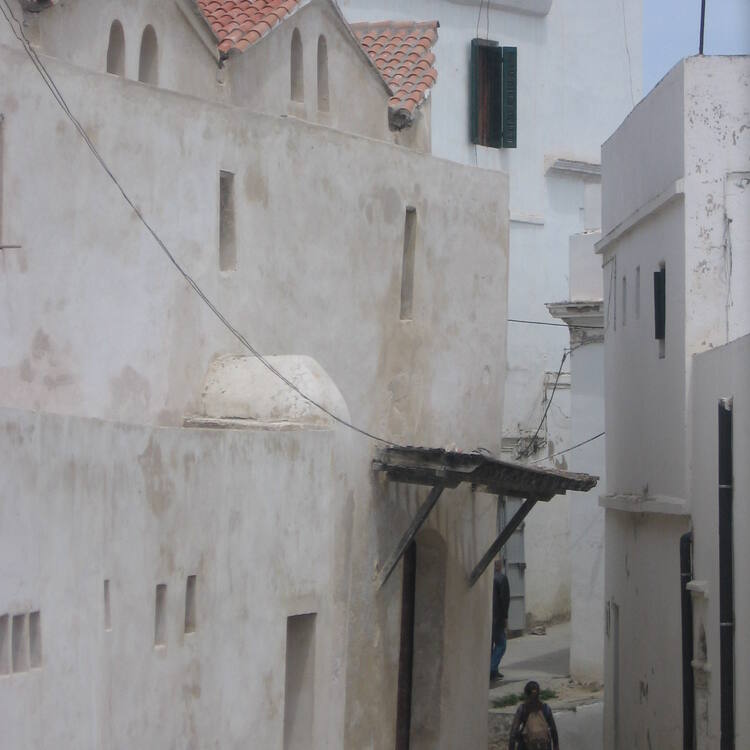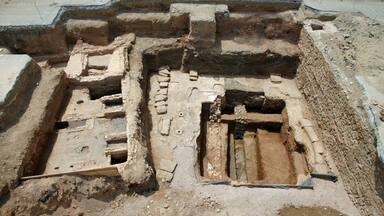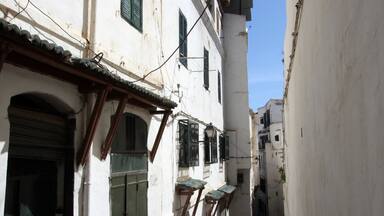Kasbah of Algiers
Kasbah of Algiers
The Kasbah is a unique kind of medina, or Islamic city. It stands in one of the finest coastal sites on the Mediterranean, overlooking the islands where a Carthaginian trading-post was established in the 4th century BC. There are the remains of the citadel, old mosques and Ottoman-style palaces as well as the remains of a traditional urban structure associated with a deep-rooted sense of community.
Description is available under license CC-BY-SA IGO 3.0
Casbah d'Alger
Dans l’un des plus beaux sites maritimes de la Méditerranée, surplombant les îlots où un comptoir carthaginois fut installé dès le IVe siècle av. J.-C., la Casbah constitue un type unique de médina , ou ville islamique. Lieu de mémoire autant que d’histoire, elle comprend des vestiges de la citadelle, des mosquées anciennes, des palais ottomans, ainsi qu’une structure urbaine traditionnelle associée à un grand sens de la communauté.
Description is available under license CC-BY-SA IGO 3.0
قصبة الجزائر
في أحد أجمل المواقع البحرية الواقعة على المتوسط، تشرف القصبة على الجزر الصغيرة حيث تمّ إنشاء مركز تجاري قرطاجي منذ القرن الرابع قبل الميلاد. وتشكّل القصبة مدينة فريدة من نوعها بين المدن الإسلامية. إنها مكان ذكريات بقدر ما هي مكان تاريخي، فهي تضم بقايا قلعة ومساجد قديمة وقصورا عثمانية، بالإضافة إلى بنية حضرية تقليدية تتميّز بروح العيش مع الجماعة.
source: UNESCO/CPE
Description is available under license CC-BY-SA IGO 3.0
阿尔及尔城堡
卡斯巴哈是典型的麦地那式(medina)或伊斯兰建筑风格的古城,位于阿尔及尔,是地中海最美的海滨城市之一,对面的岛屿曾是迦太基人公元前四世纪建立的贸易港。城内不仅有要塞、古清真寺和土耳其风格宫殿遗址,还有传统城市的踪迹,体现了深厚的社区生活特色。
source: UNESCO/CPE
Description is available under license CC-BY-SA IGO 3.0
Касба (старая часть) города Алжир
Касба – название медины, или традиционного исламского города. Этот город расположен на одном из самых интересных прибрежных участков Средиземноморья, с видом на острова, где в IV в. до н.э. была основана торговая фактория Карфагена. Здесь находятся руины цитадели, старые мечети и дворцы в турецком стиле. Также сохранились фрагменты древней городской планировки, отражающей традиционное чувство общности его жителей.
source: UNESCO/CPE
Description is available under license CC-BY-SA IGO 3.0
Kasba de Argel
La kasba de Argel es un ejemplo de medina único en su género. Está emplazada en uno de los más bellos paisajes costeros del Mediterráneo, desde el que se dominan los islotes donde los cartagineses instalaron una factoría en el siglo IV a.C. Sitio de memoria e historia, la kasba posee vestigios de una ciudadela, mezquitas antiguas y palacios otomanos, así como una estructura urbana tradicional asociada a un profundo sentido comunitario.
source: UNESCO/CPE
Description is available under license CC-BY-SA IGO 3.0
アルジェのカスバ
source: NFUAJ
De Kasbah van Algiers
De Kasbah van Algiers is een unieke soort medina of (oudste gedeelte van een) Islamitische stad. De medina ligt in een van de mooiste kustgebieden aan de Middellandse Zee, met uitzicht op de eilanden waar in de 4e eeuw voor Christus een Carthaagse handelspost werd opgericht. In Kasbah zijn overblijfselen te vinden van de citadel, oude moskeeën en Ottomaanse paleizen. Verder laat de stad zien dat het een traditionele, stedelijke structuur kende waarbij het gemeenschapsgevoel erg belangrijk was. De historische stad heeft veel invloed uitgeoefend op de stedenbouw in het westerse deel van de Middellandse Zee en Sub-Sahara-Afrika.
Source: unesco.nl
Outstanding Universal Value
Brief synthesis
The Kasbah of Algiers is an outstanding example of a historic Maghreb city having had extensive influence on town-planning in the western part of the Mediterranean and sub-Saharan Africa.
Indeed, located on the Mediterranean coast, the site was inhabited at least from the 6th century BC when a Phoenician trading post was established there. The term Kasbah, that originally designated the highest point of the medina during the Zirid era, today applies to the ensemble of the old town of El Djazair, within the boundaries marked by the ramparts and built at the end of the 16th century, dating back to the Ottoman period.
In this living environment where nearly 50,000 people reside, very interesting traditional houses, palaces, hammams, mosques and various souks are still conserved, the urban form of which bears witness to an effect of stratification of several styles in a complex and original system that has adapted remarkably well to a very hilly and uneven site.
Criterion (ii): The Kasbah of Algiers has exercised considerable influence on architecture and town-planning in North Africa, Andalusia and in sub-Saharan Africa during the 16th and 17th centuries. These exchanges are illustrated in the specific character of its houses and the density of its urban stratification, a model of human settlement where the ancestral lifestyle and Muslim customs have blended with other types of traditions.
Criterion (v): The Kasbah of Algiers is an outstanding example of a traditional human settlement representing a profoundly Mediterranean Muslim culture, synthesis of numerous traditions. The vestiges of the citadel, ancient mosques, Ottoman palaces, as well as a traditional urban structure associated with a strong sense of community testify to this culture and are the result of its interaction with the various layers of populations.
Integrity (2009)
Despite the changes and the earthquake risks experienced by the site, the Kasbah of Algiers still retains its integrity. On the whole, the aesthetic character, material used and the architectural elements retain their original aspect that expresses the values for which the site was inscribed on the World Heritage List in 1992. The continuing residential function has strengthened the viability of the site as well as the integrity of its image. Restoration work of the built heritage of the Kasbah undertaken in the framework of the Safeguarding and Valorisation Plan is in conformity with the local and national standards and contributes towards maintaining the integrity of the site. Nevertheless, there are threats to the integrity linked to densification and uncontrolled interventions. Other risks originate from earthquakes and fire, as well as landslides and floods.
Authenticity (2009)
The attributes of the Outstanding Universal Value for which the site was inscribed are maintained. The Kasbah bears witness to a remarkable authenticity, as regards the form and conception (very dense urban planning), construction materials (earthen bricks, earthen and lime rendering, stone and wood) and also the use (residential, trading, cult) and popular customs. The survival of traditional architectural skills, notably in the building trades and architectural decoration, is a major advantage in support of the Outstanding Universal Value.
Protection and management requirements (2009)
The Kasbah of Algiers was listed as a national historic site in November 1991 and safeguarded sector in 2003. The legal framework that ensures its protection incorporates the Laws 98.04 (concerning the protection of cultural heritage), 90.25, 90.29, 91.10 and the Executive Decrees 90.78, 90.175, 91.176, 91.177 and 91.178. The State Party considers, however, that it is necessary to revise the legal and administrative provisions relating to the property to improve its protection and enhancement.
The management of the site is entrusted to the Cultural Directorate of the Wilaya (province) of Algiers. There is a continual need to conserve and rehabilitate the property to forestall deterioration of the urban fabric. Threats from the risk of earthquakes and fire exist, whereas the land slides and floods always constitute a possible threat. A permanent plan for the safeguarding and valorisation of the safeguarded sector (PPSMVSS), codified by Executive Decree N° 324-2003 is being prepared. The management plan will cover these issues and take account of a buffer zone and regular monitoring activities. The Cultural Directorate of the Wilaya, in consultation with the President(s) of the Popular Communal Assemblies concerned, is the agent for the implementation and management of the PPSMVSS. To reinforce this action, a regulatory text is being adopted, that of the Agencies for the Safeguarded Sectors. The Office for the Management of Cultural Properties and Exploitation (OGEBC) is responsible, in the name of the Ministry of Culture, for the management of the listed archaeological and historic monuments and sites, including those located inside a safeguarded sector.





